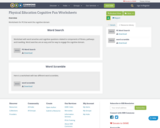
Worksheets for PE that work the cognitive domain
- Subject:
- Anatomy/Physiology
- Material Type:
- Activity/Lab
- Author:
- Emma Sullivan
- Date Added:
- 06/30/2021

Worksheets for PE that work the cognitive domain
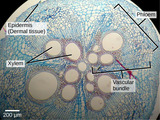
By the end of this section, you will be able to:Describe the shoot organ system and the root organ systemDistinguish between meristematic tissue and permanent tissueIdentify and describe the three regions where plant growth occursSummarize the roles of dermal tissue, vascular tissue, and ground tissueCompare simple plant tissue with complex plant tissue

OER Fundamentals are invited to remix this course planning template to design and share their OER project plans, course information and syllabus, and reflection.

This resource is a video abstract of a research paper created by Research Square on behalf of its authors. It provides a synopsis that's easy to understand, and can be used to introduce the topics it covers to students, researchers, and the general public. The video's transcript is also provided in full, with a portion provided below for preview:
"For many patients undergoing reconstruction of the ACL, the path toward recovery can be rough. One complication patients face is subsequent graft tear or injury to the opposite knee. In fact, such injuries are reported at rates of 3% at 2 years after surgery, and up to 6% at 5 years. One factor that could contribute to these statistics is anatomy. Some studies have shown that a high posterior tibial slope, or PTS, is a predictor of graft tear or contralateral ACL injury following ACL reconstruction. Others, however, have failed to produce supporting evidence. To explore that relationship, researchers examined more than 2000 ACL reconstructions with patellar tendon autograft, with a mean follow-up of 11.6 years. The PTS was measured prospectively using radiographs by subtracting from 90-degrees the acute angle formed by intersecting lines drawn along the medial tibial plateau and the posterior tibia..."
The rest of the transcript, along with a link to the research itself, is available on the resource itself.

Preface
Neural Pathways of Communication was designed for the first neurology course (known as "Neuro-1") in the master's level graduate study of Speech-Language Pathology. Our first open educational resource (OER) textbook was developed in 2020, shortly after the COVID-19 Pandemic began. Reducing the costs of study materials helps rising Speech-Language Pathologists (SLPs) progress toward their licensure and certification without interruptions due to financial setbacks. Developing the Open Education Resource (OER) resources is our ongoing effort to support rising SLPs.
A large part of this book is from various OpenStax textbook series. OpenStax is a nonprofit organization based out of Rice University in Houston, Texas. Its open resource textbooks cover a vast amount of information for two-semester core curriculum courses in various disciplines. OpenStax generously permits educators to use their books' content in part or in whole to develop textbooks customized for each instructor's course structure. The present textbook's OpenStax content is color-coded in black ink. Supplementary information concerning speech-language pathology appears in blue ink. The original OpenStax texts are accessible free of charge at https://openstax.org/subjects. This textbook incorporates applicable content from the OpenStax books, Anatomy and Physiology, Psychology, and Biology for AP® Course.
This textbook additionally contains various images produced by the renowned Dr. Willard R. Zemlin (1929-1998) with permission. Dr. Zemlin was one of the leading scholars in anatomy and physiology concerning communication sciences and disorders. Dr. Zemlin's son, Mr. Karl Zemlin, kindly sharpened numerous images to provide high-resolution pictures. Mr. Zemlin expressed gratitude for the generosity of those who donated their bodies to science throughout his father's studies. A comprehensive collection of Dr. Zemlin's work is accessible at his memorial website http://zemlin.shs.uiuc.edu/zemlinBio.htm, which Mr. Zemlin manages.
This textbook also includes additional information from Wikimedia Commons, and various information from the agencies of the United States Department of Health and Human Services. Wiki Common offers various information under Creative Common (CC) licenses, allowing the use and remix of the materials. The images and information from the U.S. federal government are in the public domain. This textbook would not have been possible without the contributions of OpenStax, Mr. Karl Zemlin, and the generous providers of Wiki Common resources. We sincerely appreciate their support. We have made this textbook available for our future colleagues to gain entry-level scientific knowledge applicable for serving individuals with communication disorders.
June S. Levitt, Ph.D., LDT, CCC-SLP
Sarah L. Guigneaux, M.S., CCC-SLP
August 2021
Contact: OpenResource2020@gmail.com
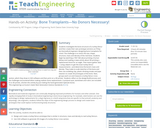
Students investigate the bone structure of a turkey femur and then create their own prototype versions as if they are biomedical engineers designing bone transplants for a bird. The challenge is to mimic the size, shape, structure, mass and density of the real bone. Students begin by watching a TED Talk about printing a human kidney and reading a news article about 3D printing a replacement bone for an eagle. Then teams gather data—using calipers to get the exact turkey femur measurements—and determine the bone’s mass and density. They make to-scale sketches of the bone and then use modeling clay, plastic drinking straws and pipe cleaners to create 3D prototypes of the bone. Next, groups each cut and measure a turkey femur cross-section, which they draw in CAD software and then print on a 3D printer. Students reflect on the design/build process and the challenges encountered when making realistic bone replacements. A pre/post-quiz, worksheet and rubric are included. If no 3D printer, shorten the activity by just making the hand-generated replicate bones.
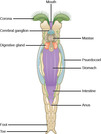
By the end of this section, you will be able to:Describe the unique anatomical and morphological features of flatworms, rotifers, Nemertea, mollusks, and annelidsDescribe the development of an extracoelomic cavityDiscuss the advantages of true body segmentationExplain the key features of Platyhelminthes and their importance as parasitesDescribe the features of animals classified in phylum Annelida

This second lesson enables students to apply what they know about human reproduction via PIV sex (Lesson 1 of this series) to other means of reproduction. They will not only learn the steps in how insemination and IVF work to create a pregnancy, but they will also learn that people other than parents can provide the genetic material (eggs, sperm, and embryos) and give birth to a child for someone else (surrogates). Students will be working in small groups to help one another understand the concepts and to practice using the inclusive language that the educator modeled in the first lesson.

Long Description:
This book was created by the students of PSY 3031: Sensation and Perception, as a class project, because there is no existing open-source textbook for S&P. Content is, for the most part, re-used and re-mixed from existing open-source materials from Psychology and Anatomy textbooks. We needed to do this project because we need a resource that goes into greater depth than the Sensation and Perception sections of introductory psychology textbooks. We also wanted to create a resource with a stronger neuroscience foundation than your average psychology textbook, with strong links between physiology and perception. The final product will always be a work in progress, but hopefully a useful collection of materials to support college-level courses that want to understand how human physiology supports human perceptual experiences.
The course has two over-arching themes or guiding principles, both of which rest on the basic understanding that perception is an interpretive act, which means that our perceptions are sometimes only loosely based on our sensory experiences: Our brains shape our environment: there are many things that we simply do not perceive because we are not prepared to perceive them. Our environments shape our brains: color categories and phonetic boundaries are just two examples of how our conscious access to sensory information is limited by the culture we grew up in.
Word Count: 63080
(Note: This resource's metadata has been created automatically by reformatting and/or combining the information that the author initially provided as part of a bulk import process.)

This activity is utilized as a method for students to commuincate their current learning, progress their understanding, and then reflect on their current understanding of a topic and share what they now think and the connections they have built.
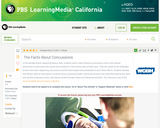
In this lesson designed to enhance literacy skills, students explore brain injuries called concussions: what they are, how they occur, the challenges in diagnosing them, and ways to protect yourself from them.
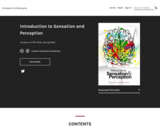
Long Description:
This book was created by the students of PSY 3031: Sensation and Perception, as a class project, because there is no existing open-source textbook for S&P. Content is, for the most part, re-used and re-mixed from existing open-source materials from Psychology and Anatomy textbooks. We needed to do this project because we need a resource that goes into greater depth than the Sensation and Perception sections of introductory psychology textbooks. We also wanted to create a resource with a stronger neuroscience foundation than your average psychology textbook, with strong links between physiology and perception. The final product will always be a work in progress, but hopefully a useful collection of materials to support college-level courses that want to understand how human physiology supports human perceptual experiences.
The course has two over-arching themes or guiding principles, both of which rest on the basic understanding that perception is an interpretive act, which means that our perceptions are sometimes only loosely based on our sensory experiences: Our brains shape our environment: there are many things that we simply do not perceive because we are not prepared to perceive them. Our environments shape our brains: color categories and phonetic boundaries are just two examples of how our conscious access to sensory information is limited by the culture we grew up in.
Word Count: 63330
ISBN: 978-1-946135-80-3
(Note: This resource's metadata has been created automatically by reformatting and/or combining the information that the author initially provided as part of a bulk import process.)

The National Center of Excellence in Women's Health and Osher Center for Integrative Medicine at UC San Francisco present lectures to provide practical, easy ways to be proactive with your health. In this episode, Susan Folkman, Director of The UCSF Osher Center, talks about learning ways to manage and cope with stress. (44 minutes)

BASIC OVERVIEW OF THE FEMALE MENSTRUAL CYCLE

This resource is a video abstract of a research paper created by Research Square on behalf of its authors. It provides a synopsis that's easy to understand, and can be used to introduce the topics it covers to students, researchers, and the general public. The video's transcript is also provided in full, with a portion provided below for preview:
"As we go about our daily lives, we aren’t generally aware of the forces generated by solar activity or the earth’s magnetic field. While these planetary changes are well documented, precisely how they affect human beings is less clear. To answer this question, researchers have turned to the autonomic nervous system – the subconscious control system that regulates bodily functions such as breathing and digestion. Their findings suggest that our nervous systems are well attuned to the energetic fluctuations that ripple through our solar system. The work builds on observations made by the famed astronomer Alexander Chizhevsky during World War I. He noted that battles intensify during peak solar flare periods and that major human events and behaviors closely follow the cycle of the sun – which led to the hypothesis that some unknown solar forces affect human health and behavior, providing a provocative link between events occurring in our solar system and life on Earth..."
The rest of the transcript, along with a link to the research itself, is available on the resource itself.

This resource is a video abstract of a research paper created by Research Square on behalf of its authors. It provides a synopsis that's easy to understand, and can be used to introduce the topics it covers to students, researchers, and the general public. The video's transcript is also provided in full, with a portion provided below for preview:
"For people with diabetes, the dangers of high blood sugar are long established. Now, scientists have uncovered additional components in the blood that can worsen the disease. In a new article in the Journal of Physiology, researchers report that microparticles shed from cells under diabetic conditions have unique inflammatory properties that may help explain the multiple organ vascular dysfunction that’s common to the disease. Microparticles have been increasingly recognized as important biomarkers in various health conditions. But most prior reports have relied on in vitro studies to evaluate particle function. Because in vitro experiments can’t fully replicate physiological conditions, defining exactly how microparticles affect disease progression has been tricky. This prompted researchers to look at the link between microparticles and diabetes-induced vascular dysfunction in vivo, in the microvessels of streptozotocin-induced diabetic rats..."
The rest of the transcript, along with a link to the research itself, is available on the resource itself.

This resource is a video abstract of a research paper created by Research Square on behalf of its authors. It provides a synopsis that's easy to understand, and can be used to introduce the topics it covers to students, researchers, and the general public. The video's transcript is also provided in full, with a portion provided below for preview:
"Salmon are famous for their swims upriver to spawn. Many people focus on this amazing feat of stamina, but even more remarkable is their ability to switch from living in freshwater to seawater, and back again. Most fish make their homes in just one type of water. So how do salmon do it? A team of biologists at Skidmore College, the U.S. Geological Survey, and the University of Gothenburg recently uncovered changes in the expression of certain genes that explain in part how Atlantic salmon make the transition. Atlantic salmon are born in freshwater, and between the ages of one and four migrate downstream to the sea. Before starting this migration, the fish undergo a months-long process preparing them for life in seawater. This is called smoltification. During this time, fish develop gill cells called ionocytes that contain specialized proteins that pump out excess salt..."
The rest of the transcript, along with a link to the research itself, is available on the resource itself.

This resource is a video abstract of a research paper created by Research Square on behalf of its authors. It provides a synopsis that's easy to understand, and can be used to introduce the topics it covers to students, researchers, and the general public. The video's transcript is also provided in full, with a portion provided below for preview:
"New research finds that female mice are most vulnerable to air pollution early in their reproductive cycle That finding calls for a closer look at menstrual cycle phase when studying air pollution effects in women Researchers gathered mice at two different stages of their reproductive cycle marked by clear differences in circulating sex hormones They then exposed each group to ozone, a reactive air pollutant known to worsen symptoms of lung disease Those in the earlier phase showed higher activation of the immune system, suggesting higher sensitivity to air pollution at that time The carryover to women hasn’t yet been explored But the overall message is clear Women’s hormonal status should always be recorded in studies on air pollution and lung inflammation Fuentes et al. "Modulation of the lung inflammatory response to ozone by the estrous cycle..."
The rest of the transcript, along with a link to the research itself, is available on the resource itself.

This resource is a video abstract of a research paper created by Research Square on behalf of its authors. It provides a synopsis that's easy to understand, and can be used to introduce the topics it covers to students, researchers, and the general public. The video's transcript is also provided in full, with a portion provided below for preview:
"Uncontrolled hypertension is a leading risk factor for cardiovascular disease. Despite available treatments, less than half of those with hypertension have optimal blood pressure control, with that percentage continuing to go down. Self-measured blood pressure monitoring (or SMBP) with clinical supports is one effective way of controlling blood pressure. Unfortunately, in the US, as few as 25% of adults with hypertension measure their blood pressure at home, and even fewer follow an [evidence-based protocol] to take regular home measurements and share them with their care team. Limited use of SMBP is due to a variety of barriers that both patients and their health care provider teams encounter. In search of ways to improve these poor statistics, the Centers for Disease Control and Prevention, the National Association of Community Health Centers, the YMCA of the USA, and the Association of State and Territorial Health Officials conducted a pilot project in nine community health centers across three states..."
The rest of the transcript, along with a link to the research itself, is available on the resource itself.
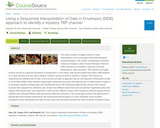
This lesson sought to engage students in data interpretation and to encourage critical thinking about neurophysiology in the context of temperature sensation. A family of receptors called Transient Receptor Potential (TRP) channels are activated in response to specific temperatures. Upon activation, TRP channels can trigger sensory neurons to signal the perception of temperature. In this lesson, that we have tested with nearly 1000 students in 12 class sections over four years, students worked in groups of three to identify a "mystery" TRP channel by interpreting five different sets of data. In this activity, we used an approach that we call Sequential Interpretation of Data in an Envelope (SIDE), where students sequentially analyze primary source-like data that are on folded pieces of paper in an envelope. Students analyzed data and hypothesized which TRP channel(s) might be their mystery TRP channel. Students then analyzed four additional sets of data from different experiments and revised their hypotheses about their mystery TRP channel after each experiment. There are four different mystery TRP channels so different groups of three students each analyzed different data and came to different conclusions. This lesson gave students the opportunity to analyze data from multiple experiments. We assessed learning through an in-class worksheet, which students completed as they interpreted each data set and a post-class homework assignment, which students completed online.